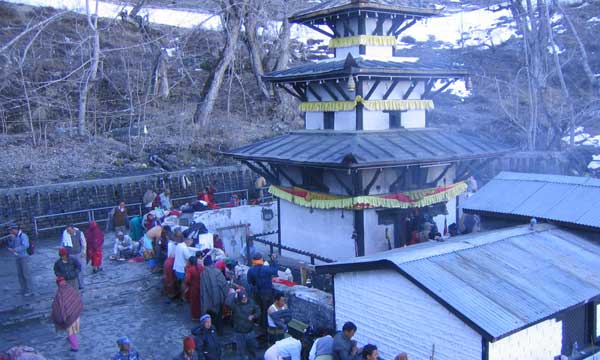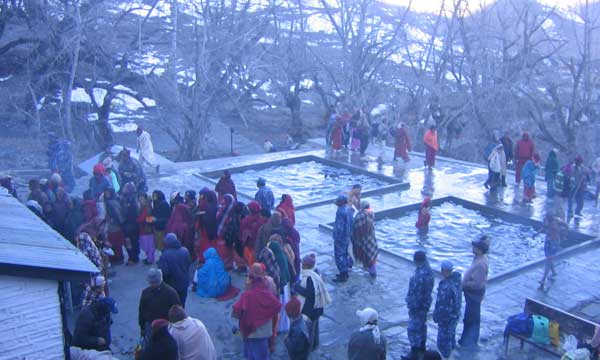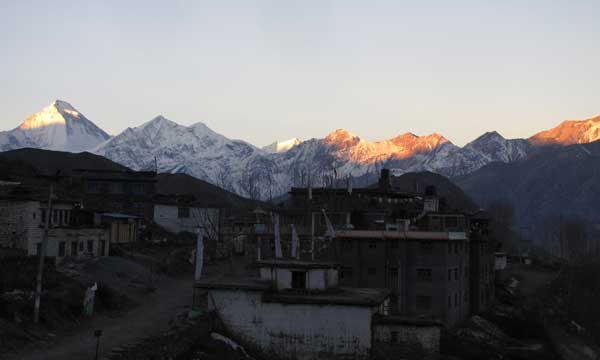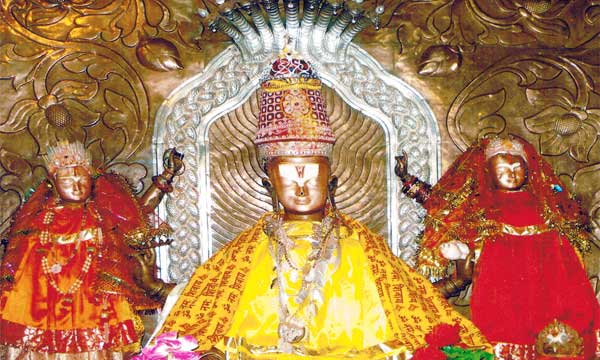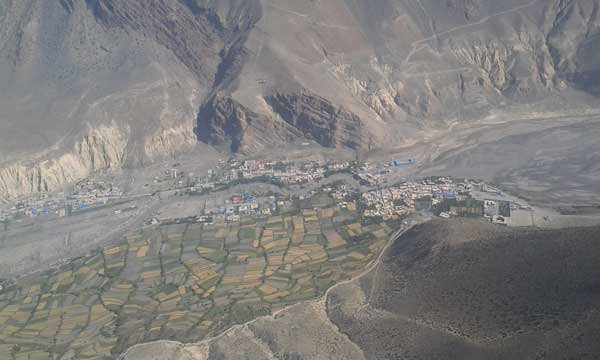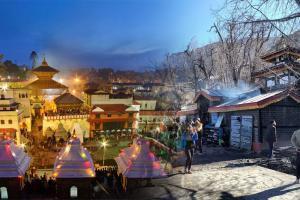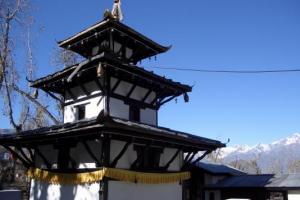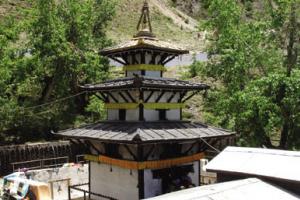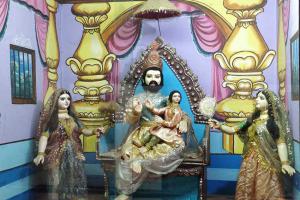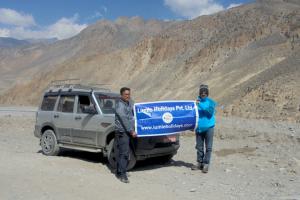Muktinath Temple Nepal: History, Travel Guide, and Tour Packages

About Muktinath Temple (मुक्तिनाथ मन्दिर):
Muktinath Temple is dedicated to the Hindu God Shri Vishnu, who is one of the 3 major deities in Hinduism. Vishnu is the god of Preservation, the great maintainer who often appears in various incarnations (avatara) to provide salvation for humanity.
At Muktinath Temple, Shri Vishnu appears as a Shaligram Shila (a sacred fossilized stone). In the process of saving the world from various negative powers, Shri Vishnu unwillingly deceived his beloved devotee Tulasi. As a consequence, he got a curse to spend his life in Shaligram Shila. Muktinath Dham is the spot where he spent his life in Shaligram form. Muktinath is one of the Eight Swayam Bhu (self-manifested) sacred sites of Shri Vishnu and one of the 108 Divya Desams revered by Vaishnavas.
It is believed that Shri Vishnu performed tough self-purification tapasya (penance) at Muktinath Kshetra to rinse his sins. After hard meditation, Shri Vishnu got salvation from the Shaligram Shila life. So, at Muktinath Temple, he appears as a God of Mukti (Salvation).
Believing this faith, thousands of pilgrims from different corners of the world, mostly from India, visit Muktinath Temple to pay respect to Shri Vishnu and to get salvation from the chain of birth and rebirth.
The exact age of the Muktinath Temple is uncertain, but the present temple, built in the pagoda style, was constructed around 1815 AD by Queen Subarna Prabha Devi, the wife of King Rana Bahadur Shah and the daughter-in-law of King Prithvi Narayan Shah.
Inside the temple, there is a human-sized copper idol of Shri Vishnu in padmasana, adorned in yellow attire. To his right stands Saraswati Mata (Bhu Devi), the goddess of knowledge, dressed in red, and to his left is Laxmi Mata (Shri Devi), the goddess of prosperity and wealth, also dressed in red. The temple also houses idols of Ganesh, Gautam Buddha, Garuda, Alwar Acharya Shri Ramanuja, and the sacred Shaligram Shila.
Meaning of the word Muktinath (Mukthinath):
The word Muktinath itself holds deep significance. The word Muktinath means the God of Salvation. We can define the term Muktinath in two words: “Mukti” and “Nath”. Mukti means salvation or nirvana, and the Nath means God or master. The words also clarify that if we are searching for salvation, then it is Muktinath Temple.
Full Documentary Video of Muktinath Temple, Hidden History and Travel Guidelines.
What is special about Muktinath Temple?
High Altitude Temple:
Muktinath Temple is the world's highest altitude located temple. The temple is situated at an elevation of 3,710 meters (12,172 feet) above sea level. Before visiting Muktinath, it is essential to acclimatize properly. Due to the reduced oxygen levels at this altitude, some individuals may experience altitude sickness. It is highly recommended that senior citizens consult a doctor before embarking on the Muktinath Yatra.
Worshipped by two religions:
Muktinath Temple is worshipped by two religions: Hindus and Buddhists. Hindus worship Muktinath as Mukti Khetra, which means place of salvation. Whereas Buddhists worship Muktinath Temple as Chumig Gyatsa, which means 100 waters. Inside the Muktinath Temple there is a human-size statue of God in the padmasana position. Hindus worship him as Shri Vishnu, whereas Chenrezig by Buddhists.
Presence of two different priests:
There is the presence of two different priests at Muktinath. Hindu priest and Buddhist priest. Hindu priests open the temple early in the morning and perform the morning arati. After arati, he handed over the temple to a Buddhist priest. We can call Buddhist priests Jhuma or Aani. She will stay the whole day inside the temple accepting different offers offered by visitors. In the evening, Buddhist priests leave the temple, and again Hindu priests enter to perform evening arati. And after evening aarti, the Muktinath Temple will be closed.
Surrounding Landscape:
The surrounding landscape is just awesome. The panoramic views of the soaring Annapurna and Dhaulagiri snow-capped mountains attract thousands of trekkers. From Muktinath, we can see the world’s 7th highest peak, Dhaulagiri Mountain, Tukuche Peak, Nilgiri Himal, Tilicho Peak, and Muktinath Peak. The barren hills landscape is another major attraction of Muktinath. Lots of Nepalese movies and songs are filmed here.
One of the Char Dham of Nepal:
Like India, Nepal also has Char Dham in various locations. They are Baraha Kshetra, Pashupat Kshetra, Mukti Kshetra, and Ruru Kshetra. Here Mukti Kshetra represents Muktinath Temple. Hindus believe it is important to visit these sites at least once in their lifetime.
Gandaki River Bathing:
Behind the temple flows the continuously running Gandaki River. Water from this river is channeled to pour through 108 cow-headed water spouts, known as the 108 Mukti Dhara. Hindus believe that bathing in these 108 Mukti Dhara has the power to cleanse past sins and bad karma. With this deep faith, pilgrims come to purify themselves by bathing in these sacred waters.

Taking Bath in 108 Mukti Dhara
Why do people visit Muktinath?
Why do Vaishnavas visit Muktinath Temple?
There are 108 Divya Desams (Divine Abodes of Lord Vishnu) revered in the Vaishnav tradition. Among these, 106 are located in the mortal realm, while the remaining two are believed to exist beyond this world. Of the 106 earthly Divya Desams, 105 are in India, and one is in Nepal. The Muktinath Temple in Nepal is considered the 106th Divya Desam. It is the cherished dream of every Vaishnava devotee to visit all 106 Divya Desams during their lifetime. As part of this spiritual journey, many Vaishnav followers visit Muktinath to bathe in the sacred 108 Mukti Dhara, purify themselves, and offer their prayers to Lord Vishnu at Muktinath.
Why do Shaivas visit Muktinath?
Muktinath Kshetra is regarded as one of the sacred Shakti Peethas. There are a total of 51 Shakti Peethas on Earth, believed to have been formed where different parts of Sati Devi (the first wife of Lord Shiva) fell. At Muktinath, it is said that the Gandak Sthal, representing the cheek of Sati Devi, fell. As a result, Shaiva devotees visit Mukteshwar Mahadev Temple, located in the premises of Muktinath, to offer their prayers and pay homage to Mahadev and Shakti.
Why do Buddhists visit Muktinath?
For followers of Guru Rinpoche, also known as Padmasambhava, Muktinath Kshetra is considered one of the 24 sacred Tantric sites. During his quest for powerful meditation spots, Guru Padmasambhava discovered Muktinath and recognized its spiritual significance. While meditating there, he encountered Sky Dakinis (celestial beings known as Sky Dancers) and joined them in their divine dance. As a result, he left his footprints in various places around Muktinath, which can still be seen today. For this reason, Buddhist devotees regard Muktinath as a profoundly powerful site for gaining Tantric energy and practicing meditation.
Why do Swaminarayan sampradaya people visit Muktinath?
The founder of the Swaminarayan Sampradaya, Swaminarayan Nilkanth Varni, was a yogi and ascetic revered by his followers as a manifestation of Lord Krishna. In the 18th century, he visited the Muktinath Temple and performed intense tapasya (penance), standing on one foot for 21 days. To honor his devotion and spiritual connection to Muktinath, many followers of the Swaminarayan tradition make pilgrimages to this sacred site.
Muktinath is a divine and spiritually powerful site where devotees come to worship Lord Vishnu, bathe in the sacred 108 Mukti Dhara for purification, seek Mukti (liberation), and immerse themselves in the breathtaking natural beauty of the surrounding landscape.

Swaminarayan Nilkanth Varni in meditation position and Vishnu Paduka
Historical importance of Muktinath Temple
According to the Devi Bhagavata Purana, Brahma Vaivarta Purana, and Shiva Purana, there was a king named Vrishadhvaja who was cursed by Surya to endure poverty for worshipping only Shiva. His grandsons, Dharmadhvaja and Kushadhvaja, performed austerities to appease Lakshmi, who incarnated as their daughters, Vedavati and Tulasi. Tulasi, desiring Vishnu as her husband, was instead married to the danava Shankhachuda, a virtuous devotee of Vishnu.
Shankhachuda conquered the three worlds: heaven (Swarga), earth (Bhuloka), and the underworld (Patala) and became invincible due to his armor and Tulasi's chastity. When the devas lost Swarga, they sought Vishnu's help. Vishnu, disguised as a Brahmin, tricked Shankhachuda into giving up his armor. He then assumed Shankhachuda's form and appeared before Tulasi, breaking her chastity. With her purity lost, Shankhachuda's invincibility ended, and Shiva killed him.
Upon learning of Vishnu's deception, Tulasi cursed him to become a stone. It is believed that Vishnu turned into a Shaligram Shila at Muktinath, where he attained liberation (Mukti) from his stone form after intense penance. After cursing Vishnu, Tulasi's body transformed into the Gandaki River, where Vishnu remains as Shaligram stones within its waters.
Where is Muktinath Temple located in map of Nepal?
This very popular Muktinath Temple is located 197 km to the northwest of Pokhara City in the Mustang District of Gandaki Province, Nepal. Muktinath Temple is situated at an altitude of 3710 meters, nestled at the base of the Thorong-La Pass, one of the highest trekking passes in the world. Muktinath Temple is also an integral part of the Annapurna Circuit Trekking Route.
Important Places to Visit in Muktinath:
- Samba Gompa: The main deities of this monastery are Shakyamuni, Chingresig, & Guru Rimpoche. The monastery is situated on the left from the main entrance gate of the Muktinath temple complex.
- Muktinath Yagyashala: Pilgrims who wish to perform yagna at Muktinath can perform in this Yagyashala.
- Vishnu Paduka: After crossing Muktinath Yagyashala, we can see Vishnu Paduka on the right-hand side. The meditation idol of the Swaminarayan Nilkanth Varani was also placed.
- Mukteshwar Mahadev Temple: Just in front of the Vishnu Paduka Mukteshwar Mahadev Temple is located. There is an idol of lord Shiva and Parvati and is considered as Shakti Peetha.
- 108 Mukti Dhara: At the back courtyard of the Muktinath Temple, there are 108 water springs popularly known as Mukti Dhara, from where water is pouring from the cow's head. It is believed that taking a bath in this chilled water has the power to rinse past sins and bad karmas, which will purify the soul.
- Paap Kunda and Punya Kunda: In the front of the temple we can find two small ponds. The flowing water of 108 Mukti Dhara is internally connected with these ponds. It's said that taking a bath in Paap Kunda will rinse the Paap and Punya to rinse Punya.
- Narshing Gompa: This monastery is dedicated to Guru Rimpoche (Padmasambhava); his huge clay image is placed at the center of the altar along with the Bon deities: red Trakpo on the right side and blue Singe Doma on the left side. Since Singe Doma is a lion-headed deity, Hindus worship the deity as Narsinha and named the monastery Narsingh Gompa.
- Jwala Mai Temple: This monastery is known as the Monastery of the Miraculous Flame. Manjushri, Avaloketeshwara, and Bajrapani are the main deities of this monastery, beneath which a natural gas blue flame burns continuously. Hindus regard this miraculous flame as an offering made by Brahma. The monastery is located south of the Muktinath temple.

Naturaly Burning Blue Flame at Jwala Mai Temple
How to reach Muktinath in Nepal?
The key place to reach before heading towards Muktinath Temple is Pokhara. Pokhara is located 200 km to the west of Kathmandu. And from Pokhara there are 4 different routes available to reach Muktinath. They are helicopters, regular flight, private jeep, and trekking.
Route I: Pokhara to Muktinath by Charter Helicopter
Pokhara to Muktinath by Helicopter Charter journey just takes 35 minutes. Chartering a helicopter from Pokhara to Muktinath is often the most comfortable option. The helicopter lands near the temple gate, and from the helipad, we need to climb about 130 steps, taking roughly 10 to 15 minutes, to reach the main temple. If we are unable to walk, then dholis are available to hire. The helicopter waits for up to 1 hour after landing, and we must report back within this time frame.
Route II: Pokhara to Jomsom by regular flight and drive to Muktinath
There are two airlines that are operating 5 flights daily to Jomsom from Pokhara. It is an 18-seater small plane and shuttles 5 flights from Pokhara to Jomsom to Pokhara. It is a 20-min flight. After reaching Jomsom, we can hire one private jeep and reach Muktinath in 1 hour. The roads are smooth and a very scenic drive. From Muktinath Jeep Station (Ranipauwa), we need to hike for about 45 mins to reach the temple. Alternatively, horses and dholis (palanquins) are available for hire.
Route III: Pokhara to Muktinath by adventurous 4-wheeler drive.
Muktinath is located 197 km to the northwest of Pokhara. Pokhara to Muktinath by road journey is very adventurous and scenic. By a private jeep, it takes us around 8 hours to reach Muktinath. Roads are a mix of smooth, rocky, and bumpy. On the way there are several tourist attraction spots. We can visit Baglung Kalikamai Mandir, Nepal’s Longest Suspension Bridge, Shaligram Museum, Galeshwor Mahadev Shakti Peetha, Natural Hot Spring, Rupse Waterfall, Marpha Village, Jomsom Village, and Kagbeni Dham. After the jeep drive, we need to hike for 45 mins to reach the temple.
Route IV: Pokhara to Muktinath by Trekking.
We can also trek to Muktinath from Pokhara. There are several options available for trekking. We can start our trek from Nayapul (1 hr drive from Pokhara), stay overnight at various teahouses, and reach Muktinath within 7/8 days. Please contact us for various options.

Muktinath Helicopter Tour Picture with Customer
How to go to Muktinath from Kathmandu?
Direct Kathmandu to Muktinath by charter helicopter.
Kathmandu to Muktinath Temple can be reached within 1 hour and 15 mins by a charter helicopter. If we have very limited time, then this option will be the best choice. In a total of 4 hours we can complete Muktinath Darshan from Kathmandu. By this option, we just need one day in Kathmandu.
Drive Kathmandu to Muktinath
Traveling to Muktinath by private jeep from Kathmandu takes two days, with each day involving an 8–9 hour scenic road journey. However, due to ongoing road widening work, 2–3 hours of the drive can be bumpy. For senior citizens, it is recommended to skip the long road journey and instead opt for a flight from Kathmandu to Pokhara, followed by a flight to Jomsom, and then a short drive to Muktinath.
Fly Kathmandu to Pokhara to Jomsom and drive to Muktinath
Flights from Kathmandu to Pokhara depart every hour, using 72-seater ATR aircraft. Seats are generally available, but during peak tourist season, it is recommended to book at least 2–3 days in advance. An overnight stay in Pokhara is necessary, as flights to Jomsom operate only in the early morning hours. From Pokhara, small 18-seater Twin Otter planes operate flights to Jomsom. These flights run daily, with just five flights scheduled between 6 AM and 10 AM, operated by only two airlines. The flight duration from Pokhara to Jomsom is approximately 20 minutes. However, securing seats on these flights is challenging, and booking at least two months in advance is highly recommended. Once in Jomsom, you can hire a private jeep to reach the Muktinath Temple in about an hour via smooth roads.
What permits are required to visit Muktinath Temple?
Muktinath Temple is located in the Annapurna Conservation Area Project. So, before going to Muktinath, we need to collect ACAP Permit from Kathmandu or Pokhara. There is a check post at Ghasa, Jomsom, and Muktinath where these permits are checked. If we reach there without this permit, then we need to pay penalties on the spot, which is just double the amount that we pay in Kathmandu and Pokhara. Just now the government has launched an online e-permit. So, no more need to visit the tourism offices. We can directly submit the online form, pay online, and collect the permit.
Which is the best time to visit Muktinath?
Muktinath Temple is open year-round for visitors. However, due to its location across the Annapurna Mountain Range and its challenging geographical setting, it's important to consider the climate before planning your trip.
The best time to visit Muktinath are March, April, May, September, October, and November. During these months, the weather is pleasant with clear skies, offering comfortable temperatures and breathtaking views of the surrounding mountains.
June, July, and August are the monsoon season in Nepal, and it is advisable to avoid visiting Muktinath during these months. Heavy rainfall can cause landslides, potentially blocking the roads to Muktinath, with no guarantee of when the road will reopen. This could result in travel disruptions, including a lack of food and accommodation options.
December, January, and February are the winter months in Nepal. Temperatures at Muktinath can drop to -10 to -15°C. While these months are ideal for experiencing snowfall, if you choose to visit during this time, it's essential to wear sufficient warm clothing to stay comfortable in the cold weather.
Muktinath Temple Pictures:

